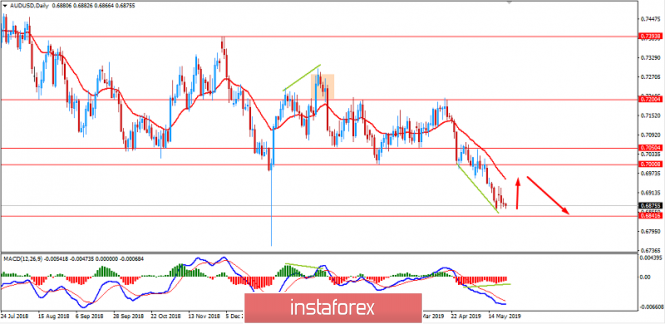The AUD/USD pair has come under bearish momentum recently pulling the price towards 0.6850 support area.
The Australian dollar has weakened against the greenback after the RBA possible decision to cut key rate next month. A cut would be the first in almost three years for the Reserve Bank of Australia. Last time, The RBA eased policy to a record low 1.50% was in August 2016. According to Governor Phillip Lowe, a lower cash rate would support employment growth and bring forward the time when inflation is consistent with the target. The RBA's concession that easier policy is required comes as labor market slack remains and amid persistent evidence that households are reining in spending and slowing the economy. Unemployment climbed to 5.2% in April and inflation in the first three months of this year was tepid.
The RBA's dovish tilt comes as growth in Australia's $1.3 trillion economy sputters. At the same time, inflation has remained under the RBA's 2-3% target band. Recently Australian Prime Minister Scott Morrison met with RBA Chief Lowe to discuss about the slowing economy and how to improve it. Morrison's Liberal National coalition promised immediate tax cuts for 10 million middle- and low-income earners - worth up to A$1,080 ($746.28) per person. Australia's crumbling housing market, where prices are down almost 10% from their 2017 highs, is also dragging on the economy.
The Australian construction sector published a report where an increase to -1.9% from -2.1% was indicated. The Australian Flash Manufacturing PMI report was published as well where the growth to 51.1 from 50.9 was presented. The Flash Services PMI showed a rise to 52.3 from 50.1.
The US economic growth beat expectations in the first quarter but later started to show signs of a slowdown. Existing home sales, which make up for about 90% of all home sales in the United States, slipped in April for the second straight month. The greenback managed to gain momentum following the US FOMC meeting minutes. The US Fed officials agreed that their current patient approach to setting monetary policy could remain in place for a certain period where policymaker see little need to change rates in either direction. By controlling short-term rates, the Fed hopes to influence the broader economy to maximize employment and keep inflation near its target. Recent weak inflation was viewed by many participants as to be transitory, while risks to financial markets and the global economy had appeared to ease - a judgment rendered before the Trump administration imposed higher tariffs on Chinese goods and took other steps that intensified trade tensions.
Today, the US Jobless Claims report is going to be published. The reading is expected to grow to 215k from 212k. The New Home Sales figure is expected to drop to 678k from 692k. The Flash Manufacturing PMI is expected to surge to 53.0 from 52.6. The Flash Services PMI might reach 53.6 from 53.0.
The US dollar is the strongest currency in the pair. However, the Australian dollar is likely to gain ground if positive economic data is provided.
Now let us look at the technical view. The price has been quite non-volatile with the recent bearish momentum which formed Bullish Divergence. As the price consolidates above 0.6850 area, certain bullish momentum is expected to reach the dynamic level of 20 EMA in the process before the price continues lower with the downtrend. As the price remains below 0.70 area with a daily close, the bearish bias is expected to continue.

